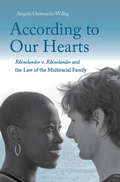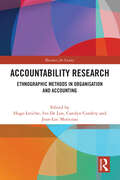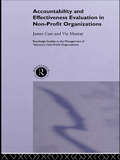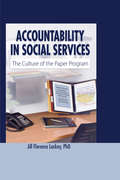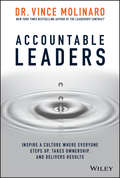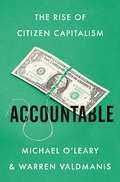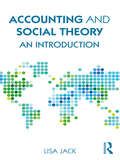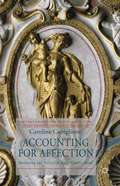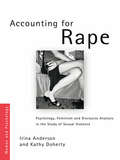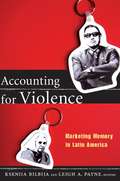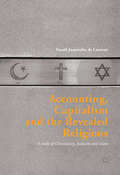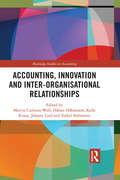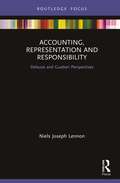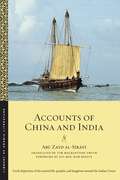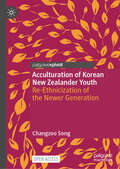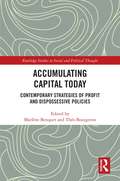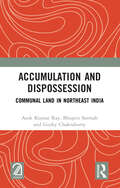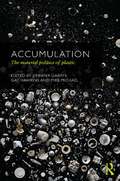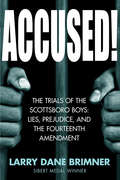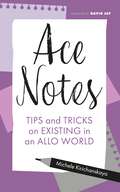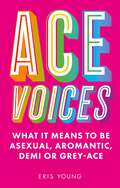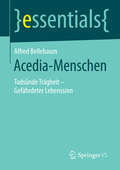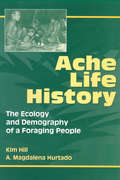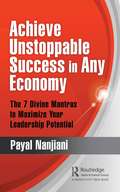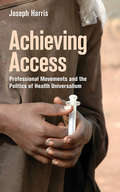- Table View
- List View
According to Our Hearts
by Angela Onwuachi-WilligThis landmark book looks at what it means to be a multiracial couple in the United States today. According to Our Hearts begins with a look back at a 1925 case in which a two-month marriage ends with a man suing his wife for misrepresentation of her race, and shows how our society has yet to come to terms with interracial marriage. Angela Onwuachi-Willig examines the issue by drawing from a variety of sources, including her own experiences. She argues that housing law, family law, and employment law fail, in important ways, to protect multiracial couples. In a society in which marriage is used to give, withhold, and take away status--in the workplace and elsewhere--she says interracial couples are at a disadvantage, which is only exacerbated by current law.
Accountability Research: Ethnographic Methods in Organisation and Accounting (Business for Society)
by Hugo Letiche Jean-Luc Moriceau Ivo De Loo Carolyn CorderyThis book discusses (auto- )ethnographies of accountability, undertaken (in close collaboration) by a multinational group of accounting and organization theory researchers over a period of three years. The key assumption underlying the book is that accountability is inherently an identity- creating process where the study of account- making has to be done participatively, with radical openness to the one(s) being researched, as well as to their context. That openness we call ‘ethnography’. The values or assumptions inherent to the practices of account and identity-making, in a specific context, are what (auto- )ethnographies seek to describe and identify. These values and assumptions warrant critical, ethical reflection, and this is what the researchers presented here have tried to provide.The chapters in this book all are mini- studies of relatedness. The scale of examination is intimate; the reflections provided by the researchers are mainly methodological.This book is of interest to accounting and organization theory students and scholars who believe that accountability can fruitfully be studied through (auto-) ethnography. The book extends currently existing views on how accountability can be handled and discharged between researchers and their researched, when local, intimate settings are studied.
Accountability and Effectiveness Evaluation in Nonprofit Organizations (Routledge Studies In The Management Of Voluntary And Non-profit Organizations Ser. #Vol. 4)
by James Cutt Vic MurrayThis unique volume provides new perspectives on assessing the performance of nonprofit organizations whilst meeting the information needs of decision-makers, both internal (such as resource-providers, regulators and clients), and external (including boards, managers, staff and volunteers).Whilst most discussions of accountability focus exclusively
Accountability in Social Services: The Culture of the Paper Program (Haworth Health and Social Policy Series)
by Jill Florence LackeyAccountability in Social Services examines how - and why - social and human services programs can function even though they are monitored by written communication instead of face-to-face interaction. Author Jill Florence Lackey draws on her experience as a consultant for more than 50 social programs and as director of two nonprofit organizations to demonstrate the strong need for accountability mechanisms and an ethics-based leadership when running social service programs. This unique book walks you through the process of how “paper programs” emerge and operate, the monitoring mechanisms that are - and aren’t - in place during program operations, and recommendations to increase accountability in the social service delivery system.The book examines programs focusing on: youth aftercare adolescent health drug prevention rural community development crime prevention violence intervention services to the homeless and more.Accountability in Social Services concludes with recommendations for organized action by consumer groups to increase responsibility in the social service delivery system. This book is invaluable as a resource for students, teachers, and practitioners working in social work and welfare, evaluation, organizational leadership, public policy, applied anthropology, and consumer science, including local organizations such as PIRGs (Public Interest Research Groups).
Accountable Leaders: Inspire a Culture Where Everyone Steps Up, Takes Ownership, and Delivers Results
by Vince MolinaroProven methods to push your organization to its maximum potential with responsible leadership Accountable Leaders is the real-world guide to propelling your business to extraordinary levels of performance and achievement. Leadership accountability is a major issue in organizations around the globe. Research has shown that teams and individual employees are overwhelmingly dissatisfied with the degree of accountability demonstrated by their leaders. Effective teams need responsible and accountable leaders—the solution seems simple. Yet, thousands of businesses are struggling with mediocre performance and widening gaps in leadership. This essential resource provides practical and no-nonsense strategies to transform any organization into a cohesive, highly motivated culture of accountable leaders and fully committed teams. Bestselling author Dr. Vince Molinaro shares his proven methods of optimal leadership accountability, providing a step-by-step blueprint for leaders in any organization. Developed from years of experience helping Fortune 500 companies build strong leaders and effective teams, this book will enable you to: Build strong leadership accountability to leverage competitive advantage, increase team performance, and close the leadership gap in your organization Understand why gaps in leadership occur and recognize accountability issues in your own organization Develop an effective strategy to instill a culture of accountability and responsibility in your business Identify and implement organizational practices that encourage accountable leadership throughout your management structure Accountable Leaders is a vital guide for anyone who leads a team: from managers and supervisors, to CEOs and CHROs. This invaluable guide will provide the tools and knowledge to take you and your organization to incredible levels of performance and achievement.
Accountable: The Rise of Citizen Capitalism
by Michael O'Leary Warren Valdmanis“More than ever before, this is the book our economy needs.” – Dr. Rajiv Shah, president of the Rockefeller Foundation“Unwilling to settle for easy answers or superficial changes, O’Leary and Valdmanis push us all to ask more of our economic system.” – Senator Michael F. BennetThis provocative book takes us inside the fight to save capitalism from itself.Corporations are broken, reflecting no purpose deeper than profit. But the tools we are relying on to fix them—corporate social responsibility, divestment, impact investing, and government control—risk making our problems worse.With lively storytelling and careful analysis, O’Leary and Valdmanis cut through the tired dogma of current economic thinking to reveal a hopeful truth: If we can make our corporations accountable to a deeper purpose, we can make capitalism both prosperous and good.What happens when the sustainability-driven CEO of Unilever takes on the efficiency-obsessed Warren Buffett? Does Kellogg’s—a company founded to serve a healthy breakfast—have a sacred duty to sell sugary cereal if that’s what maximizes profit? For decades, government has tried to curb CEO pay but failed. Why? Can Harvard students force the university to divest from oil and gas? Does it even matter if they do?O’Leary and Valdmanis, two iconoclastic investors, take us on a fast-paced insider’s journey that will change the way we look at corporations. Likely to spark controversy among cynics and dreamers alike, this book is essential reading for anyone with a stake in reforming capitalism—which means all of us.
Accounting and Social Theory: An introduction
by Lisa JackIs society possible without accounting? In speech or in writing, we communicate actions, plans and decisions using numbers, calculations, words and images. Although accounting research is dominated by quantitative analyses, the role of accounting in society is firmly established over thousands of years. In this concise book, Lisa Jack demonstrates the power of social theory in expanding the value of accounting research. Accounting and Social Theory: An introduction includes advice on research problems as well as guidance on fertile areas for new research. The tools, techniques and developments covered by the author help readers to see social research in accounting as the study of the use, misuse and abuse of accounting communications by people and the effects that this has on social relationships. Stories of accounting in war, agriculture and food, gender, health and other areas illustrate the ways in which the threads of accounting run through society. Having emerged from the author’s wealth of teaching experience, this book provides a student-focused treasure trove that illuminates the field for early-career researchers in accounting and established academics looking to expand the impact of their work.
Accounting for Affection
by Caroline CastiglioneAccounting for Affection examines the multifaceted nature of early modern motherhood by focusing on the ideas and strategies of Roman aristocratic mothers during familial conflict. Illuminating new approaches to the maternal and the familial employed by such women, it demonstrates how interventions gained increasing favor in early modern Rome.
Accounting for Rape: Psychology, Feminism and Discourse Analysis in the Study of Sexual Violence (Women and Psychology)
by Irina Anderson Kathy DohertyAccounting for Rape presents an original perspective on the subject of rape, focusing on both female and male sexual violence. The authors investigate everyday beliefs about rape, to examine how blaming the victim and the normalization of rape are achieved by people in a discussion about sexual violence. They synthesize discursive psychology and a feminist standpoint to explore precisely how rape and rape victimhood are defined in ways that reflect the social, political and cultural conditions of society. By analysing conversational data, Anderson and Doherty suggest that the existing social psychological experimental research into rape and rape perception fails to analyse the subtlety and political significance of rape supportive reasoning. Accounting for Rape provides a critical interrogation of the dominant theories and methodologies, focusing on: How the gender and sexual orientation of alleged victims and perpetrators is crucial to social participants when making sense of a rape report and in apportioning blame and sympathy How arguments that are critical of alleged victims are built in ways that are 'face saving' for the participants in the conversations, and how victim-blaming arguments are presented as 'common sense'. The potential of applying this approach in both professional and academic contexts to promote attitude change. The book will be of great interest to those studying social and clinical psychology, cultural studies, sociology, women's studies and communication studies.
Accounting for Violence: Marketing Memory in Latin America
by Leigh A. Payne Ksenija BilbijaAccounting for Violence offers bold new perspectives on the politics of memory in Latin America. Scholars from across the humanities and social sciences provide in-depth analyses of the political economy of memory in Argentina, Brazil, Chile, Mexico, Peru, and Uruguay, countries that emerged from authoritarian rule in the 1980s and 1990s. The contributors take up issues of authenticity and commodification, as well as the "never again" imperative implicit in memory goods and memorial sites. They describe how bookstores, cinemas, theaters, the music industry, and television shows (and their commercial sponsors) trade in testimonial and fictional accounts of the authoritarian past; how tourist itineraries have come to include trauma sites and memorial museums; and how memory studies has emerged as a distinct academic field profiting from its own journals, conferences, book series, and courses. The memory market, described in terms of goods, sites, producers, marketers, consumers, and patrons, presents a paradoxical situation. On the one hand, commodifying memory potentially cheapens it. On the other hand, too little public exposure may limit awareness of past human-rights atrocities; such awareness may help to prevent their recurring. Contributors. Rebecca J. Atencio, Ksenija Bilbija, Jo-Marie Burt, Laurie Beth Clark, Cath Collins, Susana Draper, Nancy Gates-Madsen, Susana Kaiser, Cynthia E. Milton, Alice A. Nelson, Carmen Oquendo Villar, Leigh A. Payne, José Ramón Ruisánchez Serra, Maria Eugenia Ulfe
Accounting, Capitalism and the Revealed Religions: A Study of Christianity, Judaism and Islam
by Vassili Joannidès de LautourThis book analyses the bearing of global monotheistic faiths towards the philosophy and practice of record keeping and accounting throughout history. The author offers a comprehensive discussion of the literal and figurative processes of taking account and ascribing accountability that link religions such as Christianity, Judaism and Islam. Chapters address theology and accounting in tandem with social behaviours to demonstrate how auditing and calculating customs permeate practising religions. This book first highlights how the four monotheisms have viewed and incorporated accounting historically, and then looks forward to the accounting debates, technologies and traditions in today’s world that derive from these religious customs. Drawing heavily on the writings of Max Weber and Werner Sombart, the author demonstrates that accounting and capitalism have religious roots far beyond the Protestant ethic.
Accounting, Innovation and Inter-Organisational Relationships (Routledge Studies in Accounting)
by Håkan Håkansson Martin Carlsson-Wall Kalle Kraus Johnny Lind Torkel StrömstenSuccessful innovation is a true challenge and especially when today’s companies are intertwined in close inter-organisational relationships and networks with e.g. customers and suppliers. Research has indicated that accounting can play important roles in such innovation processes, but there is little in-depth systematic knowledge about this issue. Accounting, Innovation and Inter-Organisational Relationships gathers leading researchers from all around the world to argue for the importance of more systematic knowledge about accounting, innovation and inter-organisational relationships. Accounting, Innovation and Inter-Organisational Relationships thus becomes an important source for researchers and practitioners interested in accounting and inter-organisational relationships as well as the related disciplines of management, marketing, innovation and strategy.
Accounting, Representation and Responsibility: Deleuze and Guattarí Perspectives (Routledge Focus on Accounting and Auditing)
by Niels Joseph LennonIn organizations, accounting produces organizational knowledge that affects decision-making and managerial action. Companies placing importance on shareholder value sometimes tend to elevate accounting to a higher truth criterion for justifying managerial actions. Yet, the nature of accounting renders it difficult to argue that accounting information necessarily produce a better basis for decision-making than arguments which are not based on accounting. This is because, as previous research has also argued, accounting counts some things but omits many others, while managers are accountable for much more than what accounting actually counts. Using a theoretical apparatus from Deleuze and Guattarí, this book illustrates that accounting-based actions such as making management decisions, maintaining organisational responsibility and hierarchical control are manifestations of the ways in which accounting is composed. This concise introduction will be invaluable for researchers and advanced students of management accounting exploring responsibility accounting and accountability.
Accounts of China and India: Accounts Of China And India And Mission To The Volga (Library of Arabic Literature #55)
by Abū Zayd al-SīrāfīThe ninth and tenth centuries witnessed the establishment of a substantial network of maritime trade across the Indian Ocean, providing the real-life background to the Sinbad tales. An exceptional exemplar of Arabic travel writing, Accounts of China and India is a compilation of reports and anecdotes about the lands and peoples of this diverse territory, from the Somali headlands of Africa to the far eastern shores of China and Korea. Traveling eastward, we discover a vivid human landscape—from Chinese society to Hindu religious practices—as well as a colorful range of natural wilderness—from flying fish to Tibetan musk-deer and Sri Lankan gems. The juxtaposed accounts create a kaleidoscope of a world not unlike our own, a world on the road to globalization. In its ports, we find a priceless cargo of information. Here are the first foreign descriptions of tea and porcelain, a panorama of unusual social practices, cannibal islands, and Indian holy men—a marvelous, mundane world, contained in the compass of a novella.An English-only edition.
Acculturation of Korean New Zealander Youth: Re-Ethnicization of the Newer Generation
by Changzoo SongThis open access book explores the acculturation, identity development, and cultural reconnection of newer-generation (1.5- and second-generation) Korean New Zealander youth who grew up in New Zealand after the 1990s. Based on in-depth interviews, it shows how many of them initially sought to assimilate into the dominant culture but later experienced a process of re-ethnicization, rediscovering their Korean heritage during adolescence and early adulthood. Chapters explore key themes such as cultural adaptation, ethnic identity, racism, co-ethnic friendships, and the role of digital media and the Korean Wave in fostering re-ethnicization. This book also situates these youth experiences within the broader contexts of New Zealand&’s multicultural policies, its bicultural foundation, multicultural frameworks and the global dynamics of diaspora and migration. Drawing on theories of segmented assimilation, transnationalism, and ethnic belonging, this book offers new insights into how young migrants navigate dual identities and negotiate belonging in an increasingly diverse and complex society for scholars and students in migration studies, sociology, diaspora studies, Asian studies and cultural studies.
Accumulating Capital Today: Contemporary Strategies of Profit and Dispossessive Policies (Routledge Studies in Social and Political Thought)
by Marlène Benquet Théo BourgeronThis book explores the renewal of forms of capital accumulation and the institutions that shape it. It focuses on three main sources of accumulation: the extraction of profit through labor and the commodification of nature, financial speculation and the ways in which profit is converted into wealth. It thus offers a new understanding of the economic and political logics of capital accumulation within capitalism in the 21st century. It shows the recomposition of the sources of profit, from the traditional mechanisms of labor exploitation to the contemporary logics of speculation and dispossession. Bringing together the work of scholars who study the social fabric of capitalist accumulation, Accumulating Capital Today goes beyond disciplinary frontiers to describe how capital is accumulating in a world threatened by social and environmental collapse. This book heralds the emergence of "accumulation studies" and will be of interest to researchers in sociology, anthropology, politics, political economy, geography and economics.
Accumulation and Dispossession: Communal Land in Northeast India
by Gorky Chakraborty Asok Kumar Ray Bhupen SarmahThis book sketches a road map of privatisation, accumulation and dispossession of communal land in the tribal areas of North East India from pre-colonial times to the neo-liberal era.Spread over five chapters, this study unfolds the privatisation of communal land in the backdrop of a larger theoretical and historical canvas. It deals with the different institutional modes of privatisation, accumulation and dispossession of communal land, the changes in land use and cropping patterns, the changes in land relations and the land-based identity of the tribal community as a result. The conclusive chapter makes a broader reflection of the grand narrative of privatisation, accumulation and dispossession of communal land in North East India.This title is co-published with Aakar Books. Print edition not for sale in South Asia (India, Sri Lanka, Nepal, Bangladesh, Pakistan and Bhutan)
Accumulation: The Material Politics of Plastic (CRESC)
by Jennifer Gabrys Gay Hawkins Mike MichaelFrom food punnets to credit cards, plastic facilitates every part of our daily lives. It has become central to processes of contemporary socio-material living. Universalised and abstracted, it is often treated as the passive object of political deliberations, or a problematic material demanding human management. But in what ways might a 'politics of plastics' deal with both its specific manifestation in particular artefacts and events, and its complex dispersed heterogeneity? Accumulation explores the vitality and complexity of plastic. This interdisciplinary collection focuses on how the presence and recalcitrance of plastic reveals the relational exchanges across human and synthetic materialities. It captures multiplicity by engaging with the processual materialities or plasticity of plastic. Through a series of themed essays on plastic materialities, plastic economies, plastic bodies and new articulations of plastic, the editors and chapter authors examine specific aspects of plastic in action. How are multiple plastic realities enacted? What are their effects? This book will be of interest to students and scholars of sociology, human and cultural geography, environmental studies, consumption studies, science and technology studies, design, and political theory.
Accused!: The Trials of the Scottsboro Boys: Lies, Prejudice, and the Fourteenth Amendment
by Larry Dane BrimnerAn ALSC Notable Children's Book * A Kirkus Reviews Best Book * A Notable Social Studies Trade Book for Young PeopleThis chilling and harrowing account tells the story of the Scottsboro Boys, nine African-American teenagers who, when riding the rails during the Great Depression, found their lives destroyed after two white women falsely accused them of rape. Award-winning author Larry Dane Brimner explains how it took more than eighty years for their wrongful convictions to be overturned.In 1931, nine teenagers were arrested as they traveled on a train through Scottsboro, Alabama. The youngest was thirteen, and all had been hoping to find something better at the end of their journey. But they never arrived. Instead, two white women falsely accused them of rape. The effects were catastrophic for the young men, who came to be known as the Scottsboro Boys. Being accused of raping a white woman in the Jim Crow south almost certainly meant death, either by a lynch mob or the electric chair. The Scottsboro boys found themselves facing one prejudiced trial after another, in one of the worst miscarriages of justice in U.S. history. They also faced a racist legal system, all-white juries, and the death penalty. Noted Sibert Medalist Larry Dane Brimner uncovers how the Scottsboro Boys spent years in Alabama's prison system, enduring inhumane conditions and torture. The extensive back matter includes an author's note, bibliography, index, and further resources and source notes.
Ace Notes: Tips and Tricks on Existing in an Allo World
by Michele KirichanskayaWhat is the ace lens?Is my relationship queerplatonic?Am I sex-favorable, sex-averse or sex-repulsed?As an ace or questioning person in an oh-so-allo world, you're probably in desperate need of a cheat sheet. Allow us to introduce your new asexual best friend, an essential resource serving up the life hacks you need to fully embrace the ace. Expect interviews with remarkable aces across the spectrum, advice on navigating different communities , and low-key ways to flaunt your ace identity.Covering everything from coming out, explaining asexuality and understanding different types of attraction, to marriage, relationships, sex, consent, gatekeeping, religion, ace culture and more, this is the ultimate arsenal for whatever the allo world throws at you.
Ace Voices: What it Means to Be Asexual, Aromantic, Demi or Grey-Ace
by Eris YoungHow do we experience attraction?What does love mean to us?When did you realise you were ace?This is the ace community in their own words. Drawing upon interviews with a wide range of people across the asexual spectrum, Eris Young is here to take you on an empowering, enriching journey through the rich multitudes of asexual life. With chapters spanning everything from dating, relationships and sex, to mental and emotional health, family, community and joy, the inspirational stories and personal experiences within these pages speak to aces living and loving in unique ways. Find support amongst the diverse narratives of aces sex-repulsed and sex-favourable, alongside voices exploring what it means to be black and ace, to be queer and ace, or ace and multi-partnered - and use it as a springboard for your own ace growth. Do you see a story like your own?
Acedia-Menschen: Todsünde Trägheit – Gefährdeter Lebenssinn (essentials)
by Alfred BellebaumAlfred Bellebaum beleuchtet die unterschiedlichen Bedeutungen sowie soziale Ursachen und manifeste soziale und individuelle Folgen von Acedia. Die gängige Übersetzung von Acedia, griech. Wortursprung, lautet Trägheit. Sie zählt zu den Sieben Todsünden - neben Hochmut, Geiz, sexueller Zügellosigkeit, Neid, Völlerei und Zorn. Unangesehen der überlieferten moralalthologischen Deutung im Sinne eines Verlustes der ewigen Seligkeit und des paradiesischen Glücks sind die gemeinten Verhaltensweisen nach wie vor hochaktuell. Durch Übertreibungen gefährden Menschen sich selbst und ihre sozialen Beziehungen. Hochmut kommt vor dem Fall.
Ache Life History: The Ecology and Demography of a Foraging People (Foundations of Human Behavior)
by Kim Hill A.Magdalena HurtadoThe Ache, whose life history the authors recounts, are a small indigenous population of hunters and gatherers living in the neotropical rainforest of eastern Paraguay. This is part exemplary ethnography of the Ache and in larger part uses this population to make a signal contribution to human evolutionary ecology.
Achieve Unstoppable Success in Any Economy: The 7 Divine Mantras to Maximize Your Leadership Potential
by Payal NanjianiHow can we increase the number of exceptional leaders in our organizations? Why is it that, despite having the best minds and hands at work, organizations aren’t seeing a significant increase in their financial numbers? How can the maximum number of people continuously generate fabulous results for themselves and for their organizations? These are some of the most pressing questions currently in organizations and form the basis for Achieving Unstoppable Success in Any Economy. This book presents the seven divine mantras for business leaders, corporate heads, entrepreneurs, and professionals to maximize leadership potential. With masterful insight and brilliant simplicity, Payal Nanjiani has distilled some of the most powerful leadership and success wisdom available for both professional and personal leadership into seven practical lessons that leaders, managers, and entrepreneurs can immediately apply to send morale and productivity soaring in these challenging and uncertain business times. Known for her coaching and consulting work with many of the world’s leading CEOs and organizations, Payal helps business professionals understand the significance of the I-Power in leadership. It highlights with certainty that for anyone to achieve unstoppable success in their job and business, and for any organization to be successful, it’s the leader who must be unstoppable first. This book serves as a wake-up call—it’s time individuals and organizations change the way they approach the human side of business, of leadership, and of success. Our society and the world at large cannot continue to withstand the increasing shortage of exceptional leaders and the widening gap between the successful few and the unsuccessful many. The challenge must be addressed in new ways to develop exceptional leaders who can deal with the immense complexities and business challenges of today. This book serves as a guide to an organic growth of people who lead and succeed regardless of the economy. The book is designed to help you become a highly inner-self-directed individual and take your leadership and business to new levels. It offers seven divine mantras that will enable you and your colleagues to move through hardship and achieve unstoppable success regardless of the economy. You will discover how to strategically direct your inner leader to leverage your potential. Ultimately, this deeply inspiring book reveals a remarkable step-by-step system that will restore trust, commitment, and spirit within your organization while transforming the way you think, act, and behave in the process. For more than 21 years, Payal Nanjiani has been sharing with Fortune 500 companies and many of the most successful entrepreneurs her success formulas that has made her one of the most sought-after leadership advisors in the world. Now, for the first time, through this book Payal makes her proprietary process available to you, so that you can deliver your best while helping your organization break through to a new level of success regardless of the economy. "In a world where burn out is becoming more common, it is imperative for leaders to constantly undergo self-reflection and assess their inner well-being and take stock of their emotions and encourage their team to do so as well. Emotional pain, if not tackled, could take a toll on innovation and productivity leading to a trickle-down negative effect. This book by Payal Nanjiani helps leaders undergo that much-needed self-reflection and solve the critical problem of productivity." Senthil Radhakrishnan, Administrative Chief and Clinical Neurosurgical PA at Duke "Payal gives practical tips to show that a positive attitude and small incremental changes can give you the ability to stand out and lead with or without authority. A must-read for a natural leader at any level!" Michelle Proctor, Principal Business Operations Officer </
Achieving Access: Professional Movements and the Politics of Health Universalism (The Culture and Politics of Health Care Work)
by Joseph HarrisAt a time when the world’s wealthiest nations struggle to make health care and medicine available to everyone, why do resource-constrained countries make costly commitments to universal health coverage and AIDS treatment after transitioning to democracy? Joseph Harris explores the dynamics that made landmark policies possible in Thailand and Brazil but which have led to prolonged struggle and contestation in South Africa. Drawing on firsthand accounts of the people wrestling with these issues, Achieving Access documents efforts to institutionalize universal healthcare and expand access to life-saving medicines in three major industrializing countries. In comparing two separate but related policy areas, Harris finds that democratization empowers elite professionals, such as doctors and lawyers, to advocate for universal health care and treatment for AIDS. Harris’s analysis is situated at the intersection of sociology, political science, and public health and will speak to scholars with interests in health policy, comparative politics, social policy, and democracy in the developing world. In light of the growing interest in health insurance generated by implementation of the Affordable Care Act (as well as the coming changes poised to be made to it), Achieving Access will also be useful to policymakers in developing countries and officials working on health policy in the United States.
